The James Brand Folsom Review
The James Brand Chapter knife was an excerise in branding. How much branding and overwrought design work could a single knife take and still be a good knife? Well, if you look at the Chapter knife you will see that the answer is a lot. That knife is singular
in how much it focuses on appearance. But the bones of the blade were quite good. Ryan over at the James Brand did a lot of stuff right in that first launch. And the second release, the County, has a similar looks-first approach and it too has received
good feedback. Ryan knows a thing or two about knives. But the knife knut in me had always wondered what a knife from James would looks like if it didn't prioritize looks.
Now we know.
Now we know.
The Folsom, a knife released with surprisingly little fanfare (compared to the effusive praise the Chapter knife generated from the shill sites), is a James
knife that doesn't worry about winning a beauty contest. And in the end, it shows, indisputably, that Ryan, and by extension, the James Brand, knows how to make a good knife. The Folsom is a sweet little blade. With a super slim handle, a classic
blade shape, and the Folsom is a distinct departure for James. This is a knife first and a branding device second.
So how does the Folsom stack up? Let's see.
Here is the product page. The Folsom costs $99. There is a murdered out version (all black), a stormtrooper version (white with black blade), and a version with blue G10 handles and an uncoated blade. Given the color and the lack of coating, that would be my #1 choice. There are no reviews, written or video. If you want a Folsom, well, tough luck as they are all sold out at the moment on the James Brand site and there are no other retailers.
Here is my review sample (sent to me via The James Brand's ad agency and to be returned), resting on my favorite woodworking tool, my Grizzly bandsaw (a G0555LX, if you must know):
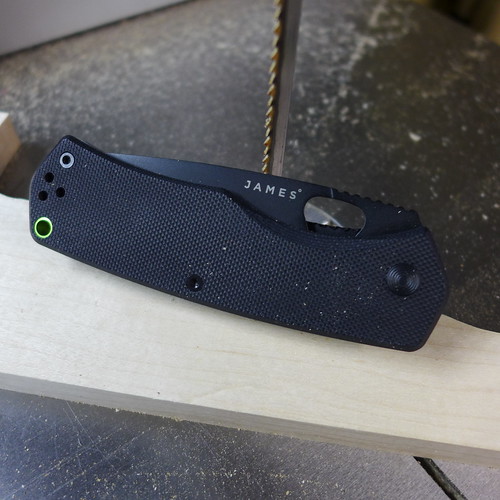
Twitter Review Summary: A marked improvement over the Chapter knife.
Design: 2
There is clearly a bit of Jesper Voxnaes in the design here, but that is not surprising. When you go for clean, minimal looks there is only so much you can do. A lot of these blades have converged on a very similar appearance, regardless of who designed them. Looks aside though Ryan, the guy behind the James Brand, did a very good job of choosing the right things. The knife is very thin, its wide in the blade, but not tall in the pocket, and the blade length, right a 2.8 inches, is short enough to keep someone clear of legal trouble in places where the laws prohibit 3 inch folders, but it is still long enough to tackle most tasks.
The only choice I do not like is the presence of a coated blade. I am not going to dock the knife a point because you can get the Folsom in an uncoated blade (the blue handle...hmmm...I like blue....). That said, with a steel like BD-1, a blade coating is done purely for looks as that steel is corrosion resistant enough not to need one. The Chapter knife was D2, and a coating, while not strictly necessary, is probably an okay idea. Here, there is no justification for it other than looks. Which is ironic because blade coatings only look cool for about fifteen minutes. Then they are just trash. So, if I had my druthers there would be no blade coatings ever, on knives. And if you had to, because it was a non-stainless steel, then okay, but that's not the case here.
The performance ratios aren't as amazing as I thought they would be given all of the other smart design decisions. The b:w is .82, nothing crazy good or bad and the b:h is .70 again nothing remarkable.
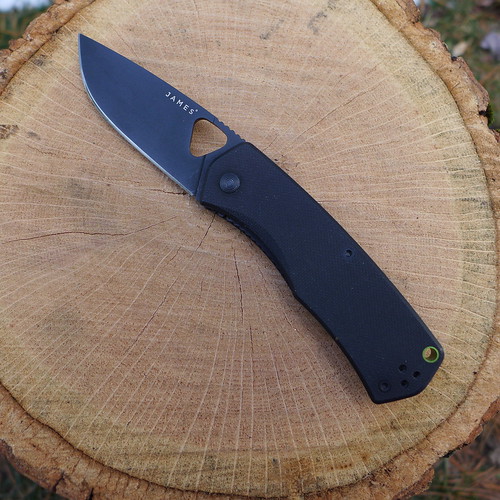
Fit and Finish: 2
As with the Chapter knife, there is a lot to like here. Everything is tight, clean, and sure. There are no errant burrs or wobbly edge profiles. The plunge lines are as perfectly symmetrical as my eyes can determine. And unlike with the Chapter knife, Ryan did not coat the lockbar interface on the tang of the blade. Everything is great and the knife looks and feels like it earns its $100 price tag.
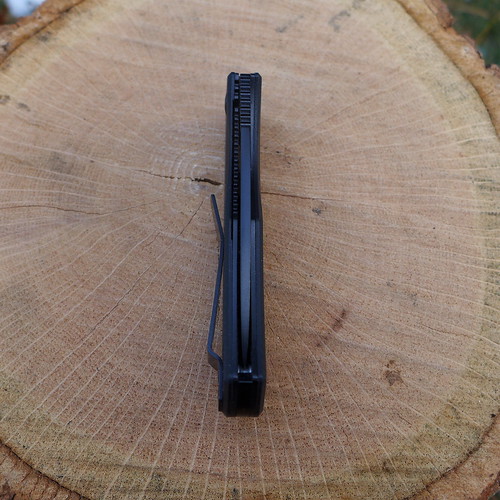
Grip: 2
I really like the Folsom in hand (but for one small issue I have with the clip, see below). The shape, the thickness, and the grippiness of the G10 are all amazing. Its hard to overstate just how thin this knife feels in the pocket. Its not just thin, it feels like the knife equivalent of switching from a hamburger thick tri-fold wallet to a thin bifold. Its almost like there is nothing there. And you should know, I am not comparing this to some Direware TFF brick, I am comparing it to stuff like the Jarosz M75, which is probably my thickest knife and is, objectively speaking, not that chunky. The cuts and curves in the profile of the handle are good too, suggesting, but not demanding, your fingers go in certain places.
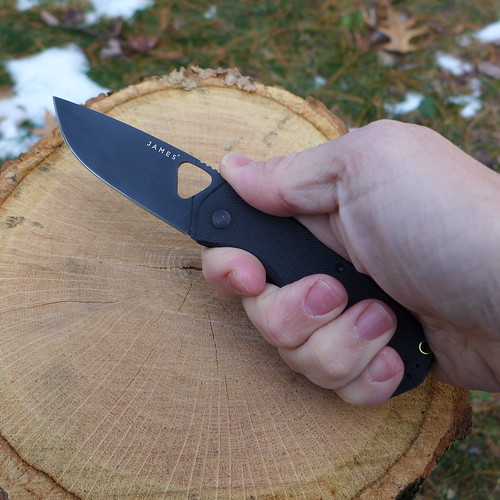
Good, Spyderco-esque, job. But the real delight is the G10. I am not sure why it is better than most. Maybe it was hit with a sander or something, but it is Goldilocks-levels of "just right." Cold Steel, this is how you do G10.
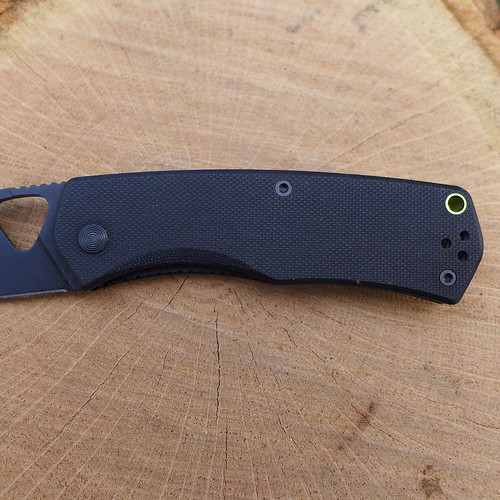
Carry: 2
Theory-reviewing this knife told me that a knife this size and possessing such a slim profile (both in thickness and height) is going to carry incredibly well. Once I had it in hand, I was proven right immediately. This is the British equivalent of a pocket inhabitant--quiet, resolute, and never complains.
Steel: 2
After Jesse Jarosz was on the podcast I got to thinking about the new class of "easy to sharpen" steels, like BD-1 and AEB-L. I am still shamelessly addicted to the high hardness stuff, like ZDP-189 and 20CV, but after a real struggle with some of the uber hard steels in sharpening (my Mnandi, in particular, has given me a hard time), I am much more open to these truly user serviceable steels. AEB-L is pretty darn nice on both my Jarosz blades--the M75 and the JFS. And here, like on the original Manix LW, the BD-1 is awesome. After some serious recycling processing the blade here was not hair popping sharp. A few minutes, literally a few, with a strop and it was back to an aggressive, cunning edge. I was quartering grapes with ease. It also helps that the blade stock here isn't brick thick. BD-1 may not be the most expensive steel, it may not hold a shaving edge for years, but it is capable of excellent performance and you never have to worry about being so lost in the sharpening process that you can't find your way back to a good edge.
Blade Shape: 2
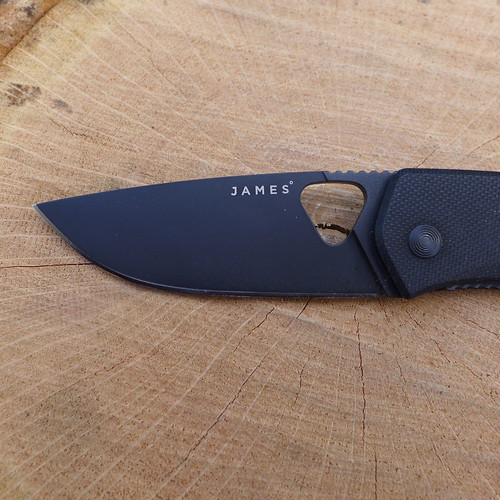
I am a sucker for a drop point. Call me a Loveless fanboy, but there is so much utility and visual delight in a well-executed drop point. And here, the drop point does not disappoint, either on the visual scale or the utility scale. Its a bit over done, maybe a comic book version of the regular drop point, with its exaggerated, almost Lionsteel SR1-level of drop point exaggeration, but the reality is, it is a great and useful blade shape. Even on a 2.8 inch blade, which is just about the ideal blade length in my mind, there is enough belly and enough straightaway to do real work. This blade shape, combined with this grind, makes the Folsom an apple slicing machine.
Grind: 2
Here is a neat trick--make a blade that is nearly the exact height of the handle, start with thin-ish blade stock, and then taper via a full flat grind until you get to the cutting bevel. The end result is a knife that slices exceptionally well. Its not as good a slicer as, say the Al Mar Falcon, but it is clearly well above average. Its not complicated to execute a superior grind, and here we have one with nice symmetry and crisp plunge lines (though the grind is clearly a CNC grind, no grinder does plunge lines like this). Be mindful of these details and anyone can make a good grind.
Deployment Method: 1
I get it. The upside down equilateral triangle allows for the blade to rest deeply in the handle and still be accessible. Its clever and it makes the knife not quite as tall in the pocket. But in the end, I feel like that was more of a style choice than a utilitarian one. A Strider-style oval hole would work just as well. In then end, it makes the knife look a little weird in the open position, which, alone I would not care enough to dock the Folsom a point, but the opening is not a smooth as it could be compared to say, a Spyderhole opener. The pad of your thumb has a tendency to get caught in the "corners" of the triangle making opening a slower than necessary affair.
Retention Method: 1
The clip is not bad, its just not great either. But it is a collection of small things that make it less than good.
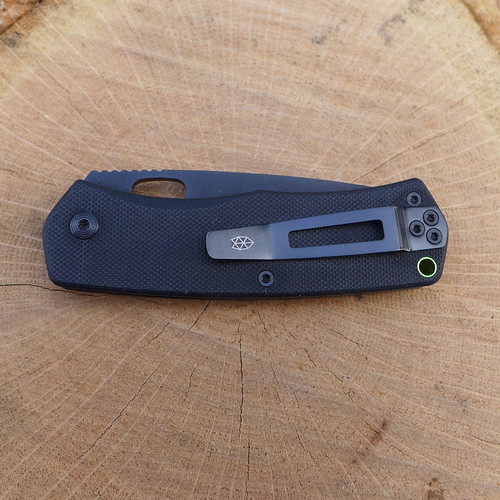
First, there is the slightly weird tension. I like my clips to be springy, yet snappy. A few clips that get this just right--the traditional Spyderco spoon clip and the KAI clip found on the Skyline and the ZT0350. For the record, the clip on the Small Shamwari is the perfect clip, but its hardly fair to compare. That was a clip designed just for me, so I am bound to like it. Here the clip is not tight enough. Its not loose or floppy, it just lacks that "grab" factor. Second, while I am not one that needs a deep carry clip, I can't think of a good reason not to have one. I do, however, think that even if you don't go the deep carry route, a clip should be as close to the end of the knife handle as possible and here, unfortunately, it is not. Finally, and this is the smallest of dings, the clip has a tendency to dig a bit in the palm of your hand because, unlike most clips, it does not angle back down at the end. If you look at clips that are this long, like the Spyderco spoon clip, it dives down towards the handle, then goes up to allow the clip to go around the lip of your pocket, and then it flattens out at the end to prevent the clip from creating a hotspot. The Folsom clip doesn't do that. And that can, in some instances, cause problems. Nothing serious, but taken together with the other issues, it is enough, in my book, to take a point away.
Lock: 2
So its not super detent-y, but the lock works well. It snaps into place, easily but with conscious effort disengages, and it has zero blade play (once I adjusted it). But this is not a liner lock you can pop open. RAT 2, this is not. But really that has more to do with our preferences at this very second in time and less to do with the performance of the lock. I am not going to dock the knife a point because it has different design features, all of which still work very well, than the current flavor of the month.
Overall Score: 18 out of 20
There is no question in my mind that the Folsom is a very good knife. It is clearly better than the Chapter knife (even though the score is the same, the reality is there is a little play in the points awarded, something could be just average and get a 1 and something else could be clearly better than average, but not great and also get a 1). The knife reminds me a lot of the Native 5, which is sort of like saying someone plays the violin like Paganini, a complement that non-aficionados would miss. The Native 5 is one of the best Spyderco designs--versatile, small, and capable. Being compared favorably to that knife is a huge deal and I think the Folsom earns the comparison. The things that held the Folsom back from a perfect score are easily corrected. This is not a knife that cannot be improved, but the improvements are niceties and not necessities.
More importantly, the Folsom represents real progress for the James Brand. The emphasis on performance and not appearance, the improvement of functional aspects of the knife, and the small touches all indicate that Ryan is pushing is brand forward. If the Chapter knife caught the eye of the shill site readers, the Folsom will too, but it is this increased refinement of the tool that will enamor (or should enamor) knife knuts.
If you like the look, don't worry about the function. This knife can do work. And you will be pleased. There is only one issue with the Folsom, and it is not really a problem of the knife itself. It really has to do with...
The Competition
There is really only one blade in $100 range that I feel competes with the Folsom. The Delica is a bit long in the tooth and if you exclude sprint runs with better steel, I am not sure why anyone would choose the harder-to-sharpen-and-just-as-quick-to-dull VG10 over BD-1. I also like the Folsom better than the basic version of the Mini Grip. The handle feels better than than hollow jelly bean and the steel isn't all that much worse, overall. The much cheaper Kershaw Skyline is a viable competitor, but not squarely in competition. The real issue, for me, is that the Native 5 in S35VN is $83.95. I think the Native 5 in S35VN is a clearly superior choice--the round hole, the forward finger choil, the awesome standard spoon-style clip, and the categorically improved steel make it an openly comparable, but better, knife. Its not as thin and lacks G10 handle scales (which I could care less about), but it is also almost $20 cheaper.
In the end, I feel like the Folsom, while very good in a vacuum, faces stiff competition from the Native 5 (as do all other sub-$100 knives). And the fact that the Folsom is an overseas made product, compared to the Native-ly produced Spyderco blade, makes the choice easy for me. If the Folsom were $80, then it would be a more interesting debate. That said, if you like the looks go for the Folsom, it doesn't disappoint. Its the Willie McCovey of the 1960s Giants--an all time great, but always in the shadow of Willie Mays.
So how does the Folsom stack up? Let's see.
Here is the product page. The Folsom costs $99. There is a murdered out version (all black), a stormtrooper version (white with black blade), and a version with blue G10 handles and an uncoated blade. Given the color and the lack of coating, that would be my #1 choice. There are no reviews, written or video. If you want a Folsom, well, tough luck as they are all sold out at the moment on the James Brand site and there are no other retailers.
Here is my review sample (sent to me via The James Brand's ad agency and to be returned), resting on my favorite woodworking tool, my Grizzly bandsaw (a G0555LX, if you must know):

Twitter Review Summary: A marked improvement over the Chapter knife.
Design: 2
There is clearly a bit of Jesper Voxnaes in the design here, but that is not surprising. When you go for clean, minimal looks there is only so much you can do. A lot of these blades have converged on a very similar appearance, regardless of who designed them. Looks aside though Ryan, the guy behind the James Brand, did a very good job of choosing the right things. The knife is very thin, its wide in the blade, but not tall in the pocket, and the blade length, right a 2.8 inches, is short enough to keep someone clear of legal trouble in places where the laws prohibit 3 inch folders, but it is still long enough to tackle most tasks.
The only choice I do not like is the presence of a coated blade. I am not going to dock the knife a point because you can get the Folsom in an uncoated blade (the blue handle...hmmm...I like blue....). That said, with a steel like BD-1, a blade coating is done purely for looks as that steel is corrosion resistant enough not to need one. The Chapter knife was D2, and a coating, while not strictly necessary, is probably an okay idea. Here, there is no justification for it other than looks. Which is ironic because blade coatings only look cool for about fifteen minutes. Then they are just trash. So, if I had my druthers there would be no blade coatings ever, on knives. And if you had to, because it was a non-stainless steel, then okay, but that's not the case here.
The performance ratios aren't as amazing as I thought they would be given all of the other smart design decisions. The b:w is .82, nothing crazy good or bad and the b:h is .70 again nothing remarkable.

Fit and Finish: 2
As with the Chapter knife, there is a lot to like here. Everything is tight, clean, and sure. There are no errant burrs or wobbly edge profiles. The plunge lines are as perfectly symmetrical as my eyes can determine. And unlike with the Chapter knife, Ryan did not coat the lockbar interface on the tang of the blade. Everything is great and the knife looks and feels like it earns its $100 price tag.

Grip: 2
I really like the Folsom in hand (but for one small issue I have with the clip, see below). The shape, the thickness, and the grippiness of the G10 are all amazing. Its hard to overstate just how thin this knife feels in the pocket. Its not just thin, it feels like the knife equivalent of switching from a hamburger thick tri-fold wallet to a thin bifold. Its almost like there is nothing there. And you should know, I am not comparing this to some Direware TFF brick, I am comparing it to stuff like the Jarosz M75, which is probably my thickest knife and is, objectively speaking, not that chunky. The cuts and curves in the profile of the handle are good too, suggesting, but not demanding, your fingers go in certain places.

Good, Spyderco-esque, job. But the real delight is the G10. I am not sure why it is better than most. Maybe it was hit with a sander or something, but it is Goldilocks-levels of "just right." Cold Steel, this is how you do G10.

Carry: 2
Theory-reviewing this knife told me that a knife this size and possessing such a slim profile (both in thickness and height) is going to carry incredibly well. Once I had it in hand, I was proven right immediately. This is the British equivalent of a pocket inhabitant--quiet, resolute, and never complains.
Steel: 2
After Jesse Jarosz was on the podcast I got to thinking about the new class of "easy to sharpen" steels, like BD-1 and AEB-L. I am still shamelessly addicted to the high hardness stuff, like ZDP-189 and 20CV, but after a real struggle with some of the uber hard steels in sharpening (my Mnandi, in particular, has given me a hard time), I am much more open to these truly user serviceable steels. AEB-L is pretty darn nice on both my Jarosz blades--the M75 and the JFS. And here, like on the original Manix LW, the BD-1 is awesome. After some serious recycling processing the blade here was not hair popping sharp. A few minutes, literally a few, with a strop and it was back to an aggressive, cunning edge. I was quartering grapes with ease. It also helps that the blade stock here isn't brick thick. BD-1 may not be the most expensive steel, it may not hold a shaving edge for years, but it is capable of excellent performance and you never have to worry about being so lost in the sharpening process that you can't find your way back to a good edge.
Blade Shape: 2

I am a sucker for a drop point. Call me a Loveless fanboy, but there is so much utility and visual delight in a well-executed drop point. And here, the drop point does not disappoint, either on the visual scale or the utility scale. Its a bit over done, maybe a comic book version of the regular drop point, with its exaggerated, almost Lionsteel SR1-level of drop point exaggeration, but the reality is, it is a great and useful blade shape. Even on a 2.8 inch blade, which is just about the ideal blade length in my mind, there is enough belly and enough straightaway to do real work. This blade shape, combined with this grind, makes the Folsom an apple slicing machine.
Grind: 2
Here is a neat trick--make a blade that is nearly the exact height of the handle, start with thin-ish blade stock, and then taper via a full flat grind until you get to the cutting bevel. The end result is a knife that slices exceptionally well. Its not as good a slicer as, say the Al Mar Falcon, but it is clearly well above average. Its not complicated to execute a superior grind, and here we have one with nice symmetry and crisp plunge lines (though the grind is clearly a CNC grind, no grinder does plunge lines like this). Be mindful of these details and anyone can make a good grind.
Deployment Method: 1
I get it. The upside down equilateral triangle allows for the blade to rest deeply in the handle and still be accessible. Its clever and it makes the knife not quite as tall in the pocket. But in the end, I feel like that was more of a style choice than a utilitarian one. A Strider-style oval hole would work just as well. In then end, it makes the knife look a little weird in the open position, which, alone I would not care enough to dock the Folsom a point, but the opening is not a smooth as it could be compared to say, a Spyderhole opener. The pad of your thumb has a tendency to get caught in the "corners" of the triangle making opening a slower than necessary affair.
Retention Method: 1
The clip is not bad, its just not great either. But it is a collection of small things that make it less than good.

First, there is the slightly weird tension. I like my clips to be springy, yet snappy. A few clips that get this just right--the traditional Spyderco spoon clip and the KAI clip found on the Skyline and the ZT0350. For the record, the clip on the Small Shamwari is the perfect clip, but its hardly fair to compare. That was a clip designed just for me, so I am bound to like it. Here the clip is not tight enough. Its not loose or floppy, it just lacks that "grab" factor. Second, while I am not one that needs a deep carry clip, I can't think of a good reason not to have one. I do, however, think that even if you don't go the deep carry route, a clip should be as close to the end of the knife handle as possible and here, unfortunately, it is not. Finally, and this is the smallest of dings, the clip has a tendency to dig a bit in the palm of your hand because, unlike most clips, it does not angle back down at the end. If you look at clips that are this long, like the Spyderco spoon clip, it dives down towards the handle, then goes up to allow the clip to go around the lip of your pocket, and then it flattens out at the end to prevent the clip from creating a hotspot. The Folsom clip doesn't do that. And that can, in some instances, cause problems. Nothing serious, but taken together with the other issues, it is enough, in my book, to take a point away.
Lock: 2
So its not super detent-y, but the lock works well. It snaps into place, easily but with conscious effort disengages, and it has zero blade play (once I adjusted it). But this is not a liner lock you can pop open. RAT 2, this is not. But really that has more to do with our preferences at this very second in time and less to do with the performance of the lock. I am not going to dock the knife a point because it has different design features, all of which still work very well, than the current flavor of the month.
Overall Score: 18 out of 20
There is no question in my mind that the Folsom is a very good knife. It is clearly better than the Chapter knife (even though the score is the same, the reality is there is a little play in the points awarded, something could be just average and get a 1 and something else could be clearly better than average, but not great and also get a 1). The knife reminds me a lot of the Native 5, which is sort of like saying someone plays the violin like Paganini, a complement that non-aficionados would miss. The Native 5 is one of the best Spyderco designs--versatile, small, and capable. Being compared favorably to that knife is a huge deal and I think the Folsom earns the comparison. The things that held the Folsom back from a perfect score are easily corrected. This is not a knife that cannot be improved, but the improvements are niceties and not necessities.
More importantly, the Folsom represents real progress for the James Brand. The emphasis on performance and not appearance, the improvement of functional aspects of the knife, and the small touches all indicate that Ryan is pushing is brand forward. If the Chapter knife caught the eye of the shill site readers, the Folsom will too, but it is this increased refinement of the tool that will enamor (or should enamor) knife knuts.
If you like the look, don't worry about the function. This knife can do work. And you will be pleased. There is only one issue with the Folsom, and it is not really a problem of the knife itself. It really has to do with...
The Competition
There is really only one blade in $100 range that I feel competes with the Folsom. The Delica is a bit long in the tooth and if you exclude sprint runs with better steel, I am not sure why anyone would choose the harder-to-sharpen-and-just-as-quick-to-dull VG10 over BD-1. I also like the Folsom better than the basic version of the Mini Grip. The handle feels better than than hollow jelly bean and the steel isn't all that much worse, overall. The much cheaper Kershaw Skyline is a viable competitor, but not squarely in competition. The real issue, for me, is that the Native 5 in S35VN is $83.95. I think the Native 5 in S35VN is a clearly superior choice--the round hole, the forward finger choil, the awesome standard spoon-style clip, and the categorically improved steel make it an openly comparable, but better, knife. Its not as thin and lacks G10 handle scales (which I could care less about), but it is also almost $20 cheaper.
In the end, I feel like the Folsom, while very good in a vacuum, faces stiff competition from the Native 5 (as do all other sub-$100 knives). And the fact that the Folsom is an overseas made product, compared to the Native-ly produced Spyderco blade, makes the choice easy for me. If the Folsom were $80, then it would be a more interesting debate. That said, if you like the looks go for the Folsom, it doesn't disappoint. Its the Willie McCovey of the 1960s Giants--an all time great, but always in the shadow of Willie Mays.
